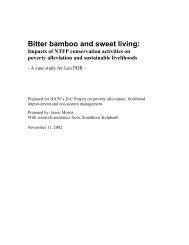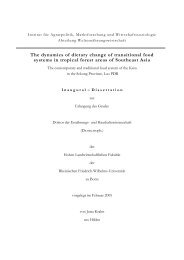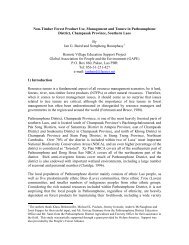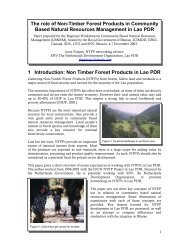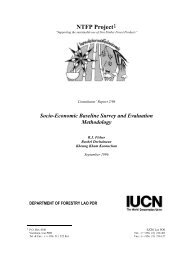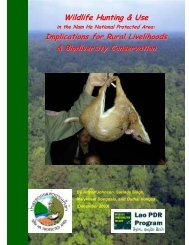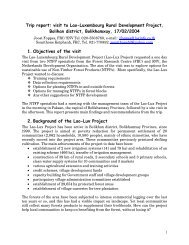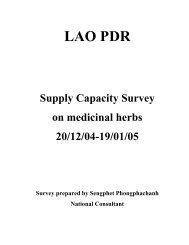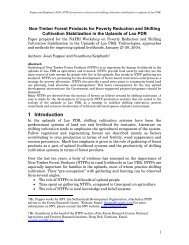You also want an ePaper? Increase the reach of your titles
YUMPU automatically turns print PDFs into web optimized ePapers that Google loves.
7 C<strong>on</strong>clusi<strong>on</strong>s<br />
7.1 What is the present use of NTFP’s in the area?<br />
Interviewed villagers could identify 306 species of NTFP’s: 223 food products and 67 n<strong>on</strong>food<br />
products. Am<strong>on</strong>g the food products, 50 species of edible leaves, 50 fruit species, 31<br />
mammals, 28 fishes were identified.<br />
Kisi resin (damar resin from Shorea sp.), fish/frogs, edible rattan shoots (Raphis sp. and<br />
Daem<strong>on</strong>orops schmidtii), cardamom (Amomum sp.) and wildlife (10%) are c<strong>on</strong>sidered by<br />
villagers to be the most important products from the forest. Food products are more numerous<br />
and c<strong>on</strong>sidered more important (56%) than n<strong>on</strong>-food products (44%).<br />
According to ranking exercises, d<strong>on</strong>e with groups of villagers, NTFP’s account for 76 % of<br />
average family income over all five villages surveyed. Livestock sales are the sec<strong>on</strong>d most<br />
important source of income (16%). Within the NTFP’s, kisi resin (14%), fish (12%),<br />
cardamom (11%) and wildlife (10 %) are the most important products sold.<br />
In the same exercise, we used to ask villagers to also rank their main expenditures. Buying<br />
rice (18%), other food (14%), clothes (13%) and medicines (12%) are c<strong>on</strong>sidered as the main<br />
family expenditures.<br />
According to a survey over 100 out of 191 individual households in the five villages visited,<br />
family ec<strong>on</strong>omies derived 41% of their income from NTFP’s, 32% from livestock sales and<br />
28% form other sources in 1996. They spent 65% of their income <strong>on</strong> buying rice in 1996.<br />
These data differ from the outcome of the ranking exercise. Group discussi<strong>on</strong>s may<br />
underestimate the income from livestock. At any rate NTFP’s are by far the most important<br />
source of income in all villages.<br />
Unprecedented floods destroyed most rice crops in the wet seas<strong>on</strong> of 1996, therefore most<br />
families must spent their entire income <strong>on</strong> buying rice in 1997. Many families will not be<br />
able to find enough m<strong>on</strong>ey to satisfy their needs in rice, even though they will sell more<br />
livestock and increase their collecti<strong>on</strong> of NTFP’s.<br />
The absolute amount of m<strong>on</strong>ey earned from NTFP’s per family does not differ very much<br />
between poor and rich families. However, in poor families NTFP’s are often the <strong>on</strong>ly source<br />
of income, they do not have access to other opti<strong>on</strong>s such as livestock raising, salaries or<br />
trading (see table 11).<br />
This finding has important implicati<strong>on</strong>s for the planning of all income generating and social<br />
activities in the resettlement scheme. Poor families the are most vulnerable when access to<br />
NTFP’s is going to be reduced by the inundati<strong>on</strong> of the former collecti<strong>on</strong> areas by the<br />
reservoir. Development agencies working with these families may want to develop special<br />
measures to counterbalance such losses.<br />
From the survey, kisi resin comes forward as the most important NTFP for income<br />
generati<strong>on</strong>, going up from 28% of NTFP based family income in 1996 to 56% of average<br />
family income in 1997 (see table 8). Curiously rattan shoots have come up to sec<strong>on</strong>d place in<br />
1997, replacing b<strong>on</strong>g bark which has been greatly reduced. This means that rattan shoots are



